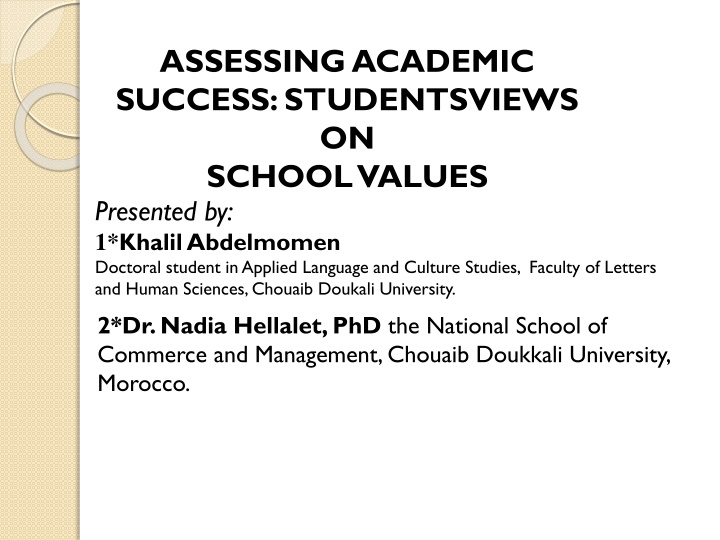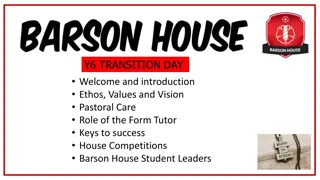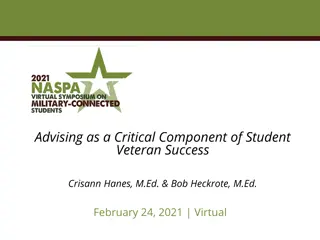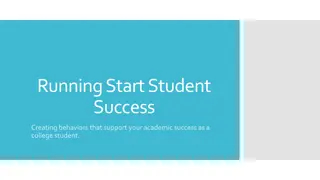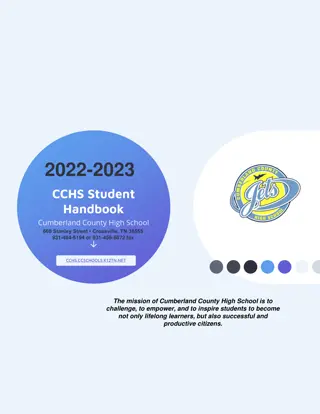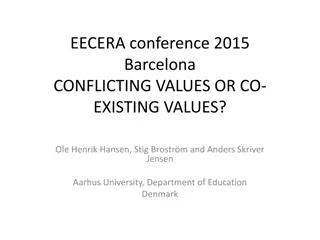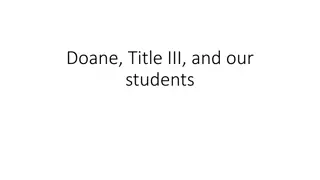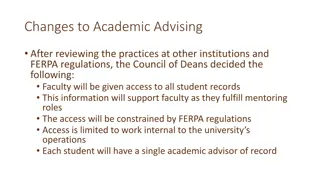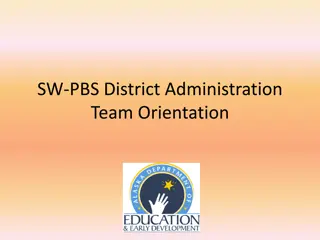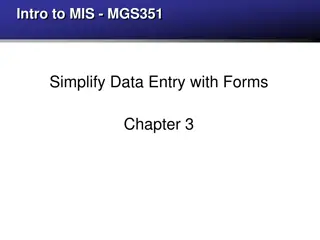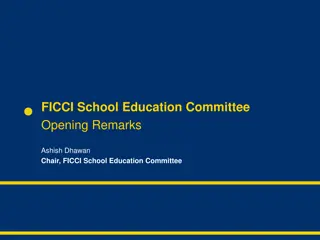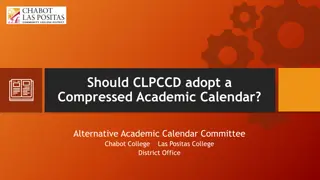Assessing Academic Success: Student Views on School Values
This study focuses on students' perceptions of school values and their impact on academic achievement. It delves into motivational theories and aims to understand students' awareness of the values upheld by educational institutions.
Uploaded on Feb 27, 2025 | 0 Views
Download Presentation

Please find below an Image/Link to download the presentation.
The content on the website is provided AS IS for your information and personal use only. It may not be sold, licensed, or shared on other websites without obtaining consent from the author.If you encounter any issues during the download, it is possible that the publisher has removed the file from their server.
You are allowed to download the files provided on this website for personal or commercial use, subject to the condition that they are used lawfully. All files are the property of their respective owners.
The content on the website is provided AS IS for your information and personal use only. It may not be sold, licensed, or shared on other websites without obtaining consent from the author.
E N D
Presentation Transcript
ASSESSING ACADEMIC SUCCESS: STUDENTSVIEWS ON SCHOOL VALUES Presented by: 1*Khalil Abdelmomen Doctoral student in Applied Language and Culture Studies, Faculty of Letters and Human Sciences, Chouaib Doukali University. 2*Dr. Nadia Hellalet, PhD the National School of Commerce and Management, Chouaib Doukkali University, Morocco.
Outline: Introduction I. Objectives II. Signifiance of the study III. Research Questions IV. Research methodology V. Participants VI. Results & Analysis VII. Research Summary
Introduction: One is by Mitchell (1982), which defines it as, "those psychological processes that cause the arousal, direction, and persistence of voluntary actions that are goal oriented" (p. 81). Phares and Chaplin (1997) define it as, "the forces within us that activate our behavior and direct it toward one goal rather than another" (p. 434). Our focus here is on students achievement motivation that has been the focus of many studies over the last 30 years. It has resulted in many models emphasizing achievement values, goal orientation, interest, and belief (Wigfield, 2010).
Expectancy-Value Theory It "focuses on individual differences in the motive to achieve and on the effects of subjective expectancy on both this motive and the incentive value of success (Eccles, 1983, p. 79).
Goal Orientation Theory Elliot & Murayama (2008) proclaimed that a goal is conceptualized as an aim that one is committed to that serves as a guide for future behavior (p. 614).
Interest John Dewy (1913) describes the interest as being engaged, engrossed, or entirely taken up with a topic, activity or task (p. 17).
Self-Efficacy (belief) Self-efficacy signifies the certainty an individual or student has to do an activity and squid on it. Another theory explaining this is the self-worth theory by (Covington 1992, 1998).
I. Objectives To explore students awareness of school value. To examine the extent to which students perception of school value affect their academic achievement.
II. Significance of the study This study will be significant: Students awareness of school value . To raise their awareness about the direct and indirect effect with their academic achievement. To enhance students goal orientation awareness and motivation.
II. Research Question What is the students perception of school value? Is students perception of school value negative or positive? How does students perception of school value affect their academic achievements?
V. Research Design To answer the research question a quantitative research design was adopted.
IV. Participants FPO undegraduate students (N=63) 40% 60% Males Females
Research instrument The self-report questionnaire method was the research instruments for the data collection. The questionnaire targeted undergraduate students at the FPO. It consists of open-ended questions and closed-ended questions.
It was adopted from the Motivated Strategies for Learning Questionnaire (MSLQ), which was designed by a group of researchers from the National Center for Research to Improve Postsecondary Teaching and Learning (NCRIFFAL).
Its questions were answered on 5-point Likert scale, ranging from strongly agree (1) to strongly disagree (4). Another option was added to the scale, which is no opinion (5) for respondents who have no idea or do not know the answer
Research variables Independent variables: Task value Expectancy for success Dependent variables: Students Grade Point Average (GPA)
Data Analysis: Obtained data was taped and analyzed using the SPSS program version 20. Used statistical analysis techniques: descriptive statistics, correlations among the variables, regression coefficient scatter plot.
Results Another important thing to note (see table 1) is students GPA. The maximum of students grade point average is 18/20; whereas its minimum is 9/20.
deviation (SD: 2.659). It is due the diversification of the student branches. Some of them were high achievers, such the one from technical branches and Physics, while others were not (literary students).
There is no correlation between GPA and task value (r = .021, p>.05). It demonstrates that students academic achievement is not controlled by the task value.
The same goes for students Expectancy for success. It has no effect on the students GPA (r=. 196, p>. 05). Additionally, there is no relationship between Self-Efficacy and GPA (r=. 085, p>. 05). This shows that whether students Self- Efficacy increases or decreases, their academic achievements will not change.
some variables appear to affect the others. The first one is choice with GPA: (r=.246, p< 0.01). It tells that a small positive correlation exists between the two variables. Others include self-efficacy and task value with a correlation coefficient of (r=. 320, *p<0.05). Also, a strong positive correlation, (r=494, **p<0.01), is present between intrinsic goal orientation and self-efficacy.
Multiple Linear Regression The unstandardized coefficient reveals that task value and extrinsic goal orientation, for example, are weak predictors of GPA. Their B values are (- 0.494) and (-0.160).
Expectancy for success and intrinsic goal orientation have B values of (0.620), and (0.776), respectively. For that reason, their predictive value is positive. Consequently, none of the independent variables seems to predict the dependent one.
Discussion According to the findings of correlations and regression no relationship was found between either task value, expectancy for success, and goal orientation with GPA. As a result, it might be ascribed to many reasons.
Why? The first one is the sample of this study. It contained both university and high school students; whereas it should have included only participants from secondary level since most of the university students are very aware of what they are doing at school.
Most of the students were not as honest as they should be, and it was shown in their answers. They did not think very carefully about the answers that reflect their real opinions. Hence, they answered the questions just to show to us or their teachers that they are satisfied with their schools so as not to be embarrassed.
Participants were asked in the first part of the questionnaire to provide their grades and it was the factor on which the independent variable measured with. As a conclusion, there was no guarantee that the scores students delivered were the exact marks they got.
Limitations The hypothesis was evaluated but it was disapproved. Its sample is small, which focused on a small number of students of FPO. The research has several aspects to be measured. It did not focus on one aspect. The use of another research design.
It investigated a limited number of teachers (only 100 participant took part in this study) in a limited number of schools. Only one data collection method was used- the questionnaire- which might not be enough to provide a clear idea about teachers use of motivational strategies.
References Mitchell, Terence R. (1982). Motivation: New Directions for Theory, Research, and Practice, The Academy of Management Review, Vol. 7, No. 1, pp.80-88. Phares, E. J., & Chaplin, W. F. (1997). Introduction to Personality (4th ed.). Englewood Cliffs. Wigfield, A., & Cambria, J. (2010). Students achievement values, goal orientations, and interest: Definitions, development, and relations to achievement outcomes. Developmental Review, 30(1), 1-35.
Thank you Thank you For your attention. For your attention. Your comments and Your comments and feedback are highly feedback are highly appreciated. appreciated.
